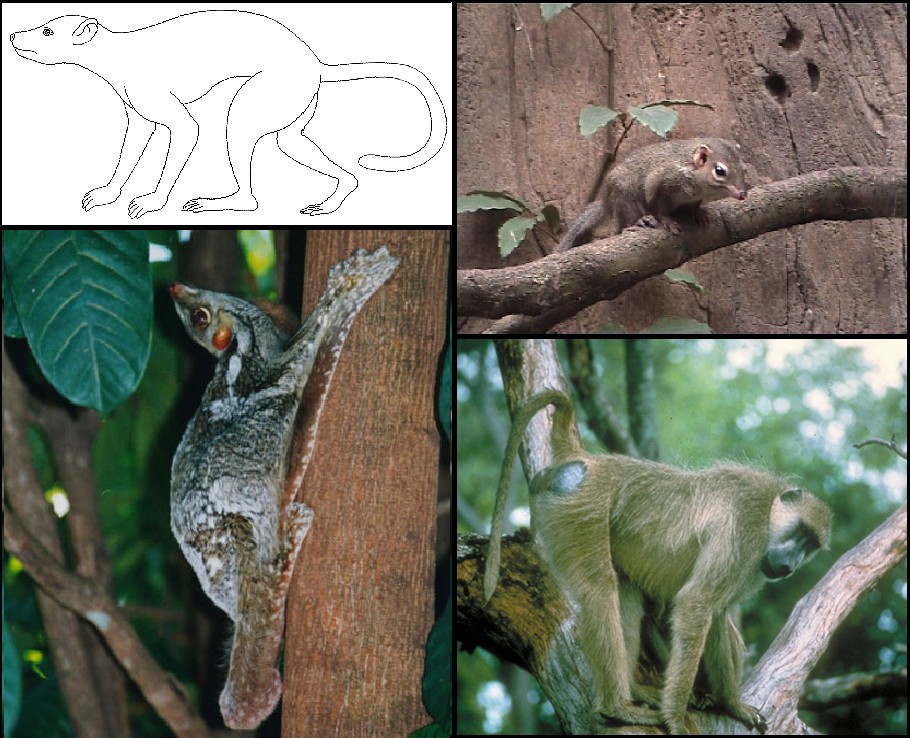- Euarchonta
Taxobox | name = Euarchontans
fossil_range =Late Cretaceous - Recent

image_caption =
regnum =Animal ia
phylum = Chordata
classis =Mammal ia
infraclassis =Eutheria
superordo =Euarchontoglires
unranked_familia = Euarchonta
subdivision_ranks = Orders
subdivision =Dermoptera
Scandentia
Plesiadapiformes (extinct)
Primates The Euarchonta are asuperorder ofmammal s containing four orders: theDermoptera or colugos, theScandentia or treeshrews, the extinctPlesiadapiformes , and thePrimate s.The term "Euarchonta" (means "true ancestors") first appeared in the general scientific literature in 1999, when molecular evidence suggested that the morphology-based
Archonta be trimmed down to exclude Chiroptera. Major DNA sequence analyses of predominantly nuclear sequences (Murphy et al., 2001) support the Euarchonta hypothesis, while a major study investigating mitochondrial sequences supports a different tree topology (Arnason et al, 2002). A study investigatingretrotransposon presence/absence data has claimed strong support for Euarchonta (Kriegs et al., 2007). However, the morphological data, together with criticism of the reliability of the molecular data, continues to call into question whether or not bats should be excluded fromArchonta .Fact|date=July 2008 In particular, some researchers believe thatbats arediphyletic ,Fact|date=July 2008 and that some bats (Megachiroptera ) are closely related toprimates (seeFlying primates theory ).Some interpretations of the molecular data link
Primates andDermoptera in aclade known asPrimatomorpha , which is the sister ofScandentia . In some the Dermoptera are a member of the primates rather than a sister. Other interpretations link the Dermoptera and Scandentia together in a group calledSundatheria as the sister group of the primates. Together, the three are known as Euarchonta, the "True Founders".Euarchonta and
Glires together form theEuarchontoglires , one of the fourEutheria n clades.Clade
label1=Euarchontoglires
1=Clade
label1=Glires
1=Clade
1=Rodent ia (rodents)
2=Lagomorpha (rabbits, hares, pikas)
label2=Euarchonta
2=Clade
1=Scandentia (treeshrews)
2=Clade
1=Dermoptera (flying lemurs)
2=Clade
1=†Plesiadapiformes
2=Primate sReferences
*Murphy W. J., E. Eizirik, W. E. Johnson, Y. P. Zhang, O. A. Ryder, S. J. O'Brien, 2001a. Molecular phylogenetics and the origins of placental mammals "Nature" 409:614-618. [http://www.ncbi.nlm.nih.gov/entrez/query.fcgi?cmd=retrieve&db=pubmed&list_uids=11214319&dopt=Abstract]
*Ulfur Arnason, et al. Mammalian mitogenomic relationships and the root of the eutherian tree. "Proceedings of the National Academy of Science" 99: 8151-8156. [http://www.pnas.org/cgi/content/full/99/12/8151]
*Jan Ole Kriegs, Gennady Churakov, Jerzy Jurka, Jürgen Brosius, and Jürgen Schmitz (2007) Evolutionary history of 7SL RNA-derived SINEs in Supraprimates. Trends in Genetics 23 (4): 158-161 [http://dx.doi.org/10.1016/j.tig.2007.02.002] (PDF version [http://zmbe2.uni-muenster.de/expath/articles/31_Kriegs_TiG.pdf] )
Wikimedia Foundation. 2010.
